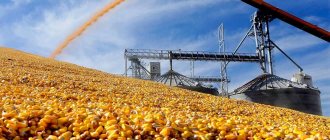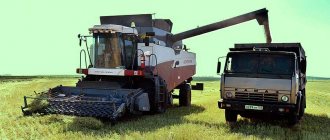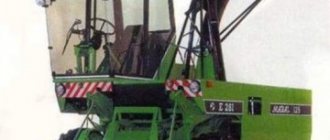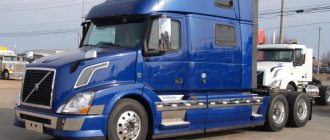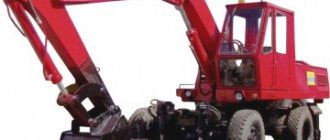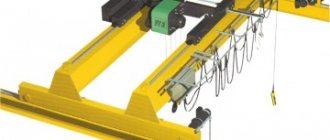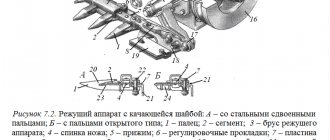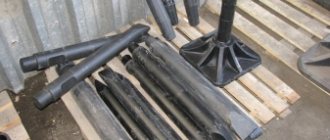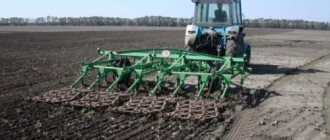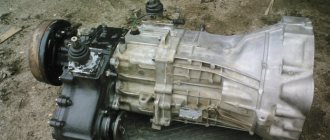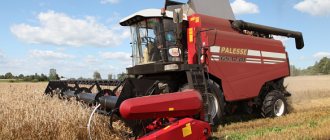Forage harvester - used for mowing and selecting cultivated and wild grasses, tall plants, chopping and loading the resulting mass for further transportation. By design they are divided into self-propelled and trailed, and by type of chopper - into drum and disk. The main units of the combine are the header (picker), feeder, chopping apparatus, and transport devices. As a rule, the drive of the working parts for self-propelled combines is hydraulic, for trailed ones - from the power take-off shaft of the traction machine. The working width of the treated area can reach 12 meters. Modern combine harvesters have a fully automated control and monitoring system, for example, like a beet harvester.
Purpose
The combine is designed to perform operations for harvesting green fodder, silage, haylage, mowing sunflower, corn at any stage of grain ripeness and other tall crops, selecting grass mass from windrows, followed by grinding and moving it to vehicles. Palesse 600 can be used in conjunction with auxiliary equipment to increase efficiency.
The equipment is suitable for operation in various soil and climatic zones, with the exception of zones with highly moist soil and mountainous areas. It is also not recommended to use the machine on flat fields with a slope of more than 8 degrees. The use of KSK 600 Polesie in the Central, Siberian, Ural and North-Western districts has shown that the model works effectively in most of the territory of the Russian Federation.
Forage harvester Claas Jaguar 850
The German brand Claas has been operating in the agricultural machinery market for almost 100 years. The brand's products are popular among consumers due to their reliability and high technical parameters. Every domestic farmer dreams of a Claas combine, but not everyone can afford this machine. 5 models of the brand are officially exported to Russia. Among forage harvesting equipment, the most popular is the Klaas Jaguar 850 combine harvester.
The equipment is characterized by a high level of performance and a long service life. The combine is considered the best-selling model in the forage harvester segment worldwide. The main features of the Claas Jaguar 850 are:
- high daily productivity;
- great loading capabilities;
- unrivaled operational efficiency.
Video
The Klaas Jaguar 850 is a real “monster” in terms of functionality and at the same time very friendly to the operator. In terms of operating comfort and control, this model has no competitors. The combine also stands out for its abundance of advanced technical solutions. Thus, its design uses the technology of absolutely rectilinear feed movement (Jaguar Green Eye). There are no narrowings or turns during the path between the feed rollers and the silo guide valve.
Claas Jaguar 850 is a typical German product with all the advantages inherent in the technology of this manufacturer. Using a combine, you can perform a wide range of jobs that allow you to collect and prepare plant matter for feed. The model is used for the following operations:
- harvesting and mowing of various types of crops and grasses with different stem heights, including tall stems. Klaas Jaguar 850 works equally effectively in wild and cultivated fields;
- chopping plant mass to a predetermined length of segments;
- selection of windrows from cut and dried stems;
- Loading the resulting mass and rolls into the bodies and trailer trolleys of carriers for further transportation.
Modifications and features
Palesse 600 FS60 is offered in several modifications, differing in configuration and type of engine installed. The base engine for the combine is the Yaroslavl engine (YaMZ), but OM 906 LA and SC9D 230.1G2 units can be installed upon request.
Features of the KSK 600 Polesie model:
- versatility. The combine allows you to quickly and efficiently perform a huge volume of operations (in 1 hour of operation, the equipment is capable of preparing up to 108 tons of silage or 56 tons of haylage);
- low maintenance costs. With sufficiently high productivity, the consumer will not have to seriously spend money on equipment maintenance;
- affordable price. Palesse 600 will cost less than most analogues, which, together with its high productivity, makes it a good purchase for any farm;
- the presence of modern technologies in the equipment;
- a feeding apparatus protection system as standard, ensuring maximum safety of the combine;
- high build quality.
Self-propelled forage harvester KSK-600 “PALESSE FS60”
The KSK-600 “PALESSE FS60” forage harvester has become known as an economical and affordable model for wide use. The combine confidently performs operations for preparing silage, haylage and green fodder. To increase operational stability, a power supply protection system is included in the basic package. When a signal is received from a metal detector or stone detector, the automation instantly turns off the roller drive, preventing breakdown.
By purchasing the PALESSE FS60, the agricultural producer receives a compact all-rounder that confidently performs all operations for the preparation of crushed feed at low unit costs.
For complete pricing and availability information, please contact our sales department.
Specifications
Overall dimensions (without adapters/in transport position):
- length – 6400/8400 mm;
- width – 3640/3700 mm;
- height – 3640/3700 mm;
- wheelbase – 2025 mm;
- track width (steer/drive wheels) – 2710/2600 mm;
- ground clearance - 250 mm.
The weight of the equipment is 7800 kg. The combine is capable of moving in a speed range from 0 to 20 km/h. The maximum operating speed is 12 km/h.
Harvester performance:
- when harvesting dried grass – 39,000 kg/hour;
- when harvesting grass – 56,000 kg/hour;
- when harvesting waxy corn - 43,000 kg/hour;
- when harvesting corn of milky-waxy ripeness - 108,000 kg/hour.
Available adapters:
- standard header for grass harvesting – 5000 mm;
- header for coarse crops – 3000 mm;
- pick-up – 3000 mm.
Installation cutting height of plants:
- grass headers – 60-120 mm;
- headers for coarse crops – 120-300 mm.
The height of unloading of the crushed mass into transport is at least 3500 mm. In the waxy ripeness phase, the degree of destruction of corn grains is at least 96%.
Trailed
Trailed combine harvesters, which include the KDP-3000 model, are aggregated with a tractor and driven by the PTO. Designed for mowing coarse crops (corn of any degree of maturity, sunflower, sorghum, etc.) as well as herbs, both green and laid in windrows.
Peculiarities
The combine is equipped with headers designed for harvesting the corresponding types of plants. The disc chopper provides high quality and speed of work. Sensors that detect the ingress of stones and metal protect against damage.
The productivity of the combine directly depends on the power of the traction tractor and ranges from 43 to 90 tons of corn per silo.
Photo of the trailed combine harvester KDP-3000
Specifications
A trailed combine harvester is cheaper than a self-propelled one, allows you to use the existing tractor fleet and can be used on any type of soil. At the same time, the productivity of such equipment is usually lower, and it is designed primarily for use in small and medium-sized farms.
Technical characteristics of the trailed combine harvester Polesye 3000:
| Model | KDP-3000 |
| Traction class | 2-4 |
| Power, hp (kW) | 150-250 (110-185) |
| Header width, m | 3,0/3,4 |
| Pickup width, m | 1,85 |
| Productivity in harvesting/selecting herbs, t/h | 26/25 |
| Corn harvesting productivity, t/h | 16/43 |
| Header height for coarse crops, mm | 120 |
| Cutting height of the grass header, mm | 60 |
| Dimensions, LxWxH, mm | 8500x4440x3460 |
| Weight, kg | 630-3100 |
Forage harvesters
Forage harvesters are a type of combined machines that are used to harvest wild and seed herbs. They contain mechanisms that facilitate cutting, harvesting and crushing the mown mass, followed by laying in windrows and loading into vehicles. In addition, these units are suitable for the production of hay and silage, when their functions are reduced to the collection of withered and already mown material from the windrows and its grinding.
Types and features of the design of combines for harvesting feed
Depending on the autonomy of the power plant, forage harvesters are:
- self-propelled – they move using their own diesel engine and wheeled or tracked chassis;
- trailed - articulated with the drive unit through a towbar or power take-off shaft. Aggregated with powerful tractor equipment such as MTZ;
- semi-mounted - common in small agricultural firms and households, where they work in tandem with small mini tractors or even walk-behind tractors.
The diagram shows the typical internal structure of all forage harvesting machines, according to which they distinguish:
- 1 – separating elements;
- 2 – blades;
- 3 – reel;
- 4 – screw devices;
- 5-7 – feeders – usually 4- and 5-roller mechanisms are presented, some of them can be spring-loaded;
- 8 – plate;
- 9 – crusher;
- 10 – conveyor;
- 11 – guide pipe;
- 12 – spreader.
The principle of their operation is in many ways reminiscent of the operation of a classic grain harvester. Thanks to the dividers, the segment on which the bevel will occur is outlined. The knives cut the stems, which are picked up by platform headers. The harvested mass, passing through the grinding compartment and the auger, is fed to the feed rollers, the main function of which is to press and evenly lay the grass before final crushing. In drum or disk crushers, the spikelets are cut into uniform pieces, which are poured through silos into trucks.
Forage harvester "Jaguar" 850
A modification produced by the German brand “Claas”. It is characterized by reliable technical equipment and decent performance properties, which made it one of the most popular combine harvesters in the world. Adapted for mowing herbaceous crops and long-stemmed crops of varying ripeness. Thanks to the pick-up, it turns into a unit for making silage from dried windrows.
- powerful power plant with a good torque reserve;
- special design of V-shaped knives, which have a self-sharpening mechanism activated from the cabin;
- “CORN CRACKER” functionality, which is involved in additional crushing of the crop due to 100 teeth;
- silo pipeline with a rotary range of up to 190 0;
- hydraulic drive of the drive axle;
- fuel supply system with filter;
- “STOP ROCK” – stone detection technology to protect rotating organs;
- cabin with climate control.
Technical characteristics of the Jaguar 850 combine:
- Power – 303 kW;
- Header – 3 m;
- Cutting – 4…17 mm;
- Number of rollers – 4;
- Speed parameters – 16..40 km/h.
Combine harvester KSK-600
The brainchild of the famous Polesie brand, which differs from other models in its affordability and low resource intensity of production. It has a universal set of options that allow you to prepare silage and haylage with high quality, quickly and with maximum comfort for the combine operator. In an hour of continuous operation, such a machine can produce up to 108 tons of silage material and up to 39 tons of fresh feed.
- chevron arrangement of cutting elements with a shift in two rows;
- 5-roller feeding device with hydromechanical drive and finger reversal;
- adjustable cutting height, allowing you to mow down fallen grains, low-growing grasses and long-stemmed plants;
- functionality for copying terrain irregularities;
- reduced feed losses due to clamping mechanisms and a spring-loaded auger;
- built-in metal and stone detectors;
- extended range of rotation of the silo pipeline.
What differs from the previous model is the absence of an auto-sharpening mechanism and lower operating and transport speeds.
Operating parameters of KSK-600:
- Power – 235 hp;
- Reaping block – 3/5 m;
- cutting height – 6…30 cm;
- Fuel tank – 0.4 m3;
- Speed – 12…20 km/h;
- Weight – 7.8 tons.
Forage harvester KSK-100A
Forage harvester from, now known as “Polesie”. Appeared on the basis of the main model KSK-100, the production of which was suspended in 1986. Equipped with a 200-horsepower engine unit. It is based on a feed part with a 5-roller mechanism and a drum chopper.
- ease of operation;
- simple design diagram, which simplifies repair work;
- a cabin glazed on all sides for good 360° visibility, complemented by rear-view mirrors;
- 6-cylinder engines - SMD-72 or YaMZ-238;
- low specific resource consumption per unit of harvested mass;
- rear-wheel drive, providing excellent cross-country ability on sandy soils.
Among the disadvantages of this machine it should be noted:
- unsuitable for work in wetlands and wet soils;
- unprotected drum from stones and foreign objects;
- unsuitable for fine grinding;
- imperfect chassis.
- Power – 200 hp;
- Diesel consumption – 162..168 g/hp. in an hour;
- Productivity – up to 25 kg/s;
- Harvesting speed – up to 12 km/h;
- Cut – from 6 cm;
- The length of the workpieces is 5…100 mm.
KDP-3000
A trailed model, which is driven by the tractor's PTO and can be used for harvesting corn, sunflower, cereals, and legumes - fresh or dried in windrows.
The design of its shredder is based on a disc shredder. It is also equipped with sensors to prevent the ingress of stones and metal objects.
- an improved disc crusher with 12 radially arranged blades that effectively grinds the vegetative part of plants and hard grains;
- long service life of the feed rollers due to stone and metal detection;
- a universal trailer unit that allows you to change the traction base with little time and effort;
- compactness, facilitating storage and transportation on public roads;
- extended product warranty that lasts 24 months.
Performance indicators:
- Tractor power class – not lower than 2nd;
- Required power – 110…185 kW;
- Productivity – up to 43 t/h;
- Capture – 2/3/3.4 m;
- Cutting height – 6/12 cm;
- Weight – 3100 kg.
Forage harvester "Rostselmash" RSM 1401
New generation forage harvesting unit. It combines high labor productivity, high quality and precision of grinding, economical consumption of fuels and lubricants and ergonomic design. Its technical properties allow it to cover 18 km of field in 1 hour of field work and produce 140 tons of silage.
- direct-flow feeding of stems into the chopper;
- V-like localization scheme for knives, sharpening of which is carried out automatically;
- a large optional selection, including equipment with a roller grinder, a preservative substance distributor, a lubricant distributor, and video surveillance functionality;
- body for a worker “Comfort Cab” with 2 seats, which has built-in air conditioning, stove, refrigerator;
- panoramic windshield with a tinted layer for better visibility;
- information module “Adviser”, which controls the technological process with voice recording.
Specifications:
- Power – 400 hp;
- Capture (max.) – up to 6m;
- Diesel tank - 1.06 m 3;
- Feeder width – 68 cm;
- Cutting length – 4…17 mm;
- Movement – up to 30 km/h;
- Weight – 11 tons.
Forage harvesting equipment
KVK-800 combine "DESNA-POLESIE FS80" KSK-600 combine "DESNA-POLESIE FS60" K-G-6 combine "DESNA-POLESIE FH40" KDP-3000 combine "DESNA-POLESIE FT40" Comparison of forage harvesters Download the catalog “Forage harvesting equipment” ”
Forage harvesting complexes DESNA-POLESIE are formed on the basis of a universal energy device (UPS) and easily replaceable mounted machines aggregated with it. A complete forage harvesting complex is “four in one”. A universal power tool (UPS) is a self-propelled agricultural machine, which is distinguished by its ability to transmit up to 100% of the power through the power take-off shaft to the working (mainly rotating) parts of mounted machines mounted with it. The powerful UES attachment makes it possible to easily and quickly, without wasting time on harvesting, raise and lower mounted machines when turning at the edge of the field and when moving to another field. A semi-mounted forage harvester DESNA-POLESIE FH40 is combined with an energy source for the preparation of crushed feed. The feed apparatus of the combine is equipped with a metal detector and a stone detector.
Number of rollers+
- feeding
2
- pre-pressing
2
- Rock detector, metal detector
- Maximum number of knives on a knife disk, pcs.
12
- Options for installing knives, pcs.
12, 6, 3
- Number of throwing blades, pcs.
12
- Location of knives and throwing blades
radial
Installation cutting length, mm:+
- for coarse crops
from 5 to 48 - for herbs
from 9 to 48
Adapter working width, m:+
- Coarse crop headers/pick-up/grass headers
3,0/3,0/4,2
Installation cutting height, mm:+
- headers for coarse crops/headers for grasses (min)
100-140/60 - Silo pipeline unloading height, m
4,0
Dimensions and weight+
- In working position with mounted header for coarse crops, mm
3015/6635/4265 - In working position with the grass header mounted, mm
2950/7500/4270
- In transport position with mounted header for coarse crops, mm
8500/3090/4000
- Weight of the header for coarse crops, kg
1250
- Pick-up weight, kg
880
- Weight of grass header/transport carts, kg
1460/315
- Chopper weight, kg
1950
- Herb harvester. The system for copying the field relief and setting the cutting height guarantees an equally even cut. The reel drive pulley overrunning clutch prevents damage to the reel when the pulley rotates backwards.
- The K-G-6 complexes are equipped with pick-ups with a working width of 2.2 and 3.0 m, which ensure the selection of windrows without loss of mown mass.
- One of the features of the DESNA-POLESIE FH40 combine is a radial-disk type chopping apparatus, which ensures the highest quality of leaf and stem mass chopping.
- The header for coarse crops is capable of harvesting corn of any height and yield, regardless of sowing patterns and methods. A uniform cut is ensured by a relief copying system and setting the cutting height. Corn stalks are fed into the feeding apparatus with their lower part, which prevents the loss of cobs. Side dividers separate plants at the edge of the pen and lift downed plants.
- The metal detector and stone detector sensors send signals to the electronic control panel located in the cabin. The system reacts instantly, automatically turning off the drive of the feed rollers, and the mass supply stops.
- At the customer's request, the K-G-6 complex can be equipped with equipment for adding preservatives.
- K-G-6 consisting of “2U280A”, “2U250A” with two drive axles ensures forage harvesting in extreme conditions: on heavy soils, in conditions of prolonged rains, during autumn harvesting of waxy ripe corn, it works stably even when other machines do not can go out into the field.
- K-G-6 as part of the “U280” with one drive axle, simpler design, and therefore cheaper. This complex fully justifies itself in conditions of medium and light soils, especially since the quality and stability of operation is not inferior to modifications with all-wheel drive.
- Manufactured models and modifications of machines provide customers with a wide range of choices: everyone can purchase the K-G-6 complex in the configuration that best suits the conditions of forage procurement on the farm.
Combine harvester Jaguar-850 - reliable assistance in the process of preparing plant feed
The Jaguar-850 forage harvester is a self-propelled special unit designed for mechanization of work on the preparation of plant feed - grass mowing and primary processing for further storage and use.
Forage harvester Jaguar 850
Jaguar-850 was created by the German company Claas, known throughout the world for the production of super-reliable agricultural equipment that provides truly high quality and performance. Claas machines always ensure efficient operation and a very long service life. That is why the company’s forage harvesting “Jaguars” are currently the most popular and sold-out harvesting equipment.
With the help of Claas combines of this line, it is possible to perform a wide range of work, allowing you to fully prepare the plant mass for winter forage harvesting. These are actions such as:
- Mowing all kinds of grasses, from cultivated meadows to wild ones, with different stem heights, including tall stems.
- Grinding the mown mass to a predetermined length of segments.
- Selection of rolls of pre-cut and partially dried stems, followed by chopping.
- Loading into trailer carts and vehicle bodies for transportation to the place of further processing.
Photo of forage harvester Jaguar-850
Device
The design of the machine determines one of its most important differences - the direct movement of waste plant material from the rollers to the guide flap, as well as the high quality of grinding with maximum compactness of the cutting devices.
Engine
The engine for installation on the combine is provided by Mercedes Benz. It has:
- High power – 412 hp, which gives the special vehicle the ability to operate unhindered under conditions of any severity and load size.
- Large values of rotation frequency – 1800 rpm.
- The ability to transmit to the combine the speed of transport movement in the general flow of up to 40 km/h.
Motion drive
Depending on the need for the machine’s functions, you can choose a modification with a transport speed of up to 25 km/h or one that can easily move along with all other road vehicles at 40 km/h:
- Profistar allows you to move at a lower speed (up to 25 km/h), but makes it possible to supply maximum load at small radii of work coverage.
- Speedstar is chosen by those who need to frequently move the car over fairly long distances. It reaches a maximum speed of up to 40 km/h when second gear is engaged on the highway, giving a maximum speed of up to 25 km/h when working in meadows, and a maximum of first gear of up to 16.8 km/h.
Grinding unit
Grinding of the herbal mass occurs in a chopping drum, inside of which cutting knives are located. The economical energy consumption of this device is achieved thanks to the original arrangement of the knives, which allows for a pulling shearing cut that is gentle on machine parts rather than straight. Their placement has 2 features:
- They lie in pairs in identical planes.
- In pairs they form a V-shape.
Engine
The basic version of the KSK 600 Polesie is equipped with a YaMZ-238AK-1 diesel engine (manufacturer: Yaroslavl Motor Plant). The power plant includes the engine itself, a radiator block with a fan and exhaust, power, cooling, lubrication and fuel supply systems. The unit is mounted on the vehicle frame using shock absorbers. The radiator block is installed in a similar way. The YaMZ-238AK-1 cooling system uses water, which can be drained through drain taps. The air entering the engine is pre-cleaned in a pre-cleaner. To clean the air flow entering the cylinders, a dry type air cleaner with paper filter cartridges is used. Their contamination can be monitored using a lamp placed on the control panel. Such features make the YaMZ-238AK-1 unit unpretentious and easy to use.
Characteristics of YaMZ-238AK-1:
- working volume – 14.86 l;
- rated power – 172 (235) kW (hp);
- rated speed – 2000 rpm;
- maximum torque – 932 Nm;
- number of cylinders – 8;
- cylinder diameter – 130 mm;
- specific fuel consumption – 220 (162) g/kW per hour (g/hp per hour).
The following engines are available upon request:
- Diesel unit YaMZ-236BE2 with a V-shaped cylinder arrangement, turbocharging, direct fuel injection and liquid cooling.
Engine characteristics:
- working volume – 17.5 l;
- rated power – 184 (250) kW (hp);
- rated speed – 2000 rpm;
- maximum torque – 1078 Nm;
- number of cylinders – 6;
- cylinder diameter – 130 mm;
- specific fuel consumption – 197 (145) g/kW per hour (g/hp per hour).
- Diesel engine OM 906 LA (Mercedes-Benz) with a power of 170 (231) kW (hp). The power plant is distinguished by its reliability and high environmental friendliness and efficiency.
- Diesel unit SC9D 230.1G2 with a power of 170 (231) kW (hp). Cheaper motor.
The capacity of the fuel tank installed on the combine is 400 liters.
Forage harvester Claas Jaguar 850
Claas Jaguar 850 is a popular German forage harvester. The model is characterized by the highest level of quality and technical performance, due to which it remains among the leaders in sales volumes. The production of this series is carried out by the well-known company Claas, based in Germany. The company has centuries of experience in producing special equipment for agriculture and is valued all over the world. Several levels of quality control provide the brand’s products with the highest reliability and long service life.
Purpose
Currently, the Klaas Jaguar 850 is one of the most popular models in the manufacturer's line. The self-propelled high-performance complex is used to mechanize the entire list of operations related to the procurement of plant feed and their processing into hay or silage. With the help of Claas Jaguar 850, the following work can be performed:
- mowing grass of various types (wild plants and cultivated meadows with varying stem heights, including tall stems);
- selection of windrows of pre-mown and dried grasses with subsequent grinding;
- chopping the mown grass to a given length of segments;
- loading the mown mass into the body of a car and transport vehicle or into trailed carts.
Modifications and features
Claas Jaguar 850 represents the brand's 800 series. The manufacturer’s line also includes the 900 series, which is positioned as more productive. However, the philosophy of constructing these models is the same: outwardly they are practically no different. Structurally, the series have many common elements, and the controls and cockpits are completely identical. The key difference is the installed motor and chopping drum. The 900 series is equipped with a V-MAX drum, and the 800 series is equipped with a V-Classic drum.
Claas Jaguar 850 is available in the following modifications:
- Profistar version – the maximum transport speed is 25 km/h. Used by consumers who need maximum load at small work radii;
- Speedstar variation – the maximum transport speed is 40 km/h. The best option for regular movements.
Jaguar Claes 850 is rightfully considered the most popular model of the 800th and 900th line. The reasons for the popularity of the combine lie in the features of the technology:
- powerful roller drive mechanism;
- ability to work with maximum load;
- presence of a stone detector;
- maximum safety and operating comfort;
- proven Mercedes Benz engine with low fuel consumption and emissions;
- a modern on-board computer that provides information about the condition of the machine and harvesting of plant matter.
These advantages allow the Claas Jaguar 850 to perform a large volume of work with the highest quality. The combine has practically no disadvantages. The main disadvantage is the high price, which makes the model inaccessible to certain consumer groups.
Specifications
Dimensions:
- length (without header) – 6495 mm;
- transport height – 3897 mm;
- working width (total) – 3030 mm;
- working height (with silo extension) – 5450 mm;
- wheelbase – 2890 mm;
- ground clearance (models produced in the 2000s/2010s) – 350/450 mm
The weight of the model without header is 11550 kg. The maximum transport speed of the combine is 40 km/h, working speed is 16 m/h.
Wheel size:
- drive axle - 650/75 R 32, 710/75 R 32 or 800/65 R 32;
- steered axle - 540/65 R 24 or 600/55-26.5.
Performance characteristics:
- working width (pickup) – 2800 mm;
- working width (grass header) – 5000 mm;
- working width (corn header) – 4500 mm;
- feed chamber width – 730 mm;
- number of feeding and pressing rollers – 4;
- chopper width – 750 mm;
- chopper diameter – 630 mm;
- number of chopper knives – 24;
- chopper cutting length – 4/5.5/7/9/14/17 mm;
- unloading elevator rotation angle – 190 degrees;
- accelerator drum width – 680 mm.
The tank for water (silage additives) holds up to 375 liters of liquid, the tank for the AdBlue reagent – 130 liters.
Engine
The Claas Jaguar 850 is equipped with a powerful Mercedes Benz OM 460 LA unit. The motor provides high traction at low speeds, which distinguishes it from other power plants. To bring the engine to compliance with Tier-IV/Stage-IIIB environmental standards, the AdBlue reagent is used in the exhaust gas system for cars manufactured later than the 2010s. Another feature of the unit is the elastic connection to the chassis, which ensures a minimum of vibration and noise.
The Klaas Jaguar 850 combine harvester is designed for long-term use, which is impossible without effective heat removal from the engine. In technology, radiators installed one above the other are responsible for this function. The large radiator mesh area reduces air flow speed, preventing rapid contamination. The mesh itself is in a vertical position and is cleaned by a rotating suction arm.
Engine characteristics:
- working volume – 12.8 l;
- rated power – 335 (455) kW (hp);
- rated speed – 1800 rpm;
- number of cylinders – 6.
The combine's fuel tank capacity is 1150 liters. An additional tank allows you to increase the total volume to 1450 liters. The average fuel consumption when harvesting corn is in the range of 0.9-1.2 l/1000 kg.
Some versions of the Claas Jaguar 850 are equipped with more modern 8-cylinder Mercedes Benz OM 502 engines (displacement - 15.9 liters, power - 462 hp).
Design and operating features
The main design feature of the Klaas Jaguar 850 combine is the direct movement of the crop mass after processing from the rollers to the guide gate. At the same time, the quality of grinding remains consistently high, regardless of the conditions and nature of the work. The movement of plant mass between equipment units is carried out in a completely straight line. Optionally, the model can be equipped with an additional device for grinding mature grain mass (Korn-Cracker equipment). The operator starts it if necessary to re-grind the remaining feed with grains.
The combine is controlled by a 2-speed hydrostatic automatic transmission with electronic control. The switching cannot be called smooth, which is a shortcoming of the company. All-wheel drive is optionally available.
To work effectively with various crops, the Claas Jaguar 850 is equipped with protective and regulatory systems that operate at the entrance of the mass entering the machine. These mechanisms include the Rock Stop protective system, which prevents medium and large stones from entering the working parts of the machine, the Comfort Cut device, used to adjust the size of the crushed sections, and the feed speed control system. A metal detector is installed in the front feed roller, which detects a body of any size that is capable of magnetization. The power supply is protected from damage by instantaneous shutdown. Finding the search location and removing the item will not be difficult thanks to the location indication system.
Chopping of plant or silage mass is carried out in a classic chopping drum with cutting knives. This unit in the Klaas Jaguar 850 combine is characterized by economical energy consumption, which was achieved due to the thoughtful arrangement of the knives. Instead of a straight cut, an oblique cut (shear cut) is used here. The knives themselves are installed in pairs in identical planes, forming a V-shape. Sharpening and setting of knives is performed automatically directly from the cab (the operator does not need to disassemble the device). In this case, after sharpening, the shear bar is adjusted manually.
The combine uses a 6-stage LOC (Length-Of-Chop) cutting length adjustment gearbox. The safety of the grinding device is ensured by the Quick-Stop drive brake, which stops the grinding elements if necessary. Another important feature of the unit is the ability to change the gap between the accelerator impeller and the rear panel.
Equipment of the combine harvester "KSK-100"
In addition to the drum header, forage harvesters of this brand were equipped with so-called “grass” and “corn” reel-type headers. The “grass” header is used for mowing thin-stemmed crops up to one and a half meters high. The corn header is specially designed for mowing silage crops up to 4 meters high and stems up to 50 millimeters thick.
The brands of harvesters for coarse crops with which the KSK-100 and its modifications are aggregated are as follows: ZhKE-3.0, PKK-0200000A, PKK-0200000, KIL-0800000. Brands of pick-ups for the combine: “PTF-2.2”, “PTF-2.2-01”, “PKK-0350000, KIS-0900000”.
In addition, “UVK-F-1” equipment was installed on the “KSK-100A”, intended for the introduction of liquid organic acids when mowing plants. It consists of a four hundred liter tank, a gas jet ejector, a pump, a dispenser, a sprayer, connecting hoses and a control panel. This device weighs 170 kg.
( 2 ratings, average 4 out of 5 )
